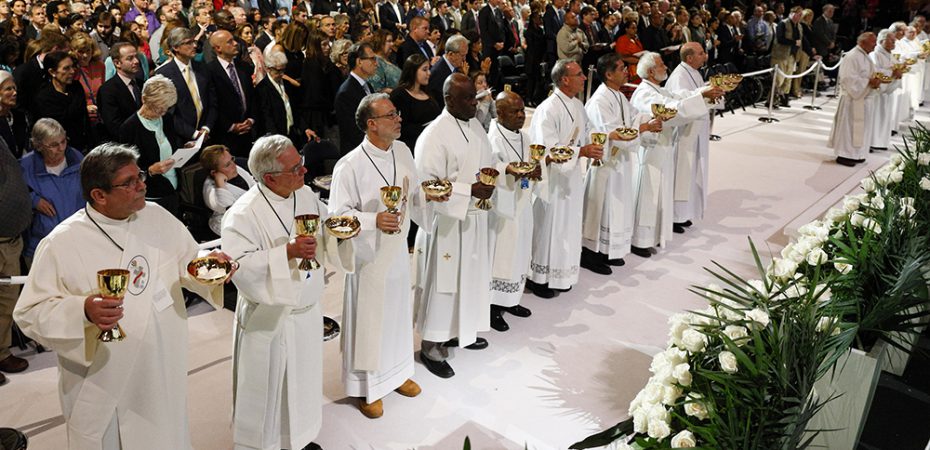‘Munera’ of Deacons
Sacramental signs and witness of the Church’s mission of service
Deacon Harold Burke-Sivers Comments Off on ‘Munera’ of Deacons
 In the ordination rite for deacons, the prayer of consecration states: “Lord, look with favor on these servants of yours, whom we now dedicate to the office of deacon, to minister at your holy altar. Lord, send forth upon them the Holy Spirit, that they may be strengthened by the gift of your sevenfold grace to carry out faithfully the work of the ministry.”
In the ordination rite for deacons, the prayer of consecration states: “Lord, look with favor on these servants of yours, whom we now dedicate to the office of deacon, to minister at your holy altar. Lord, send forth upon them the Holy Spirit, that they may be strengthened by the gift of your sevenfold grace to carry out faithfully the work of the ministry.”
The work of the ministry of the deacon is a confusing concept in the Church today. This is evidenced by the fact that laity will say to deacons, “Oh, you’re just like a priest except you can’t say Mass or hear confessions, right?” There are bishops who, 50 years after the restoration of the diaconate as a permanent order, still do not understand the theology and ministry of deacons — seeing the diaconate in competition with the priesthood — and are, therefore, reluctant to have permanent deacons in their dioceses. Some theologians posit that deacons are not necessary at all, that laity can fill the functions and roles of deacons today. This is why it is important to firmly establish the munera (functions, tasks and duties) of deacons in the liturgical and sacramental life of the Church.
The sacramental and liturgical role of the deacon is firmly established in Scripture and Tradition. In the Acts of the Apostles, the deacon Philip performs a baptism for an African eunuch: “As they traveled along the road they came to some water, and the eunuch said, ‘Look, there is water. What is to prevent my being baptized?’ Then he ordered the chariot to stop, and Philip and the eunuch both went down into the water, and he baptized him” (8:36-38).
St. Justin Martyr wrote, “When he who presides has given thanks and the people have responded, those whom we call deacons give to those present the ‘eucharisted’ bread, wine and water and take them to those who are absent” (Catechism of the Catholic Church, No. 1345).
By the fourth century, the role of the deacon was well-defined: “Linked to the bishop himself and his mission, this role [of the deacon] encompassed three tasks: the service of the liturgy, the service of preaching the Gospel and teaching catechesis, and a vast social activity concerning the works of charity and administrative action in accordance with the bishop’s directives” (“Diakonia of Christ to the Diakonia of the Apostles,” Section III).
The problem today is the laity is not catechized about the role and ministry of deacons, one of the three degrees of the Sacrament of Holy Orders, along with bishops and priests. For example, parishioners see that Jim (along with his wife) has been going through the formation process for a number of years and, before you know it, he is ordained and serving in the parish. They see Deacon Jim preaching at Mass once a month, doing baptisms, helping with RCIA and visiting parishioners in the local hospital and nursing home.
Without proper catechesis to understand why Deacon Jim is doing what he is doing, and how this is different from a layperson who may be involved in similar ministries, parishioners will view Deacon Jim as nothing more than a glorified altar server who has “taken” ministry opportunities away from competent laypeople who refer to him as the “lay deacon.”
Therefore, it is important to understand the deacon’s critical role in the Church’s liturgical and sacramental life. William T. Donovan writes: “By virtue of sacramental ordination, the deacon acts in the name of the whole Church and of Christ, and raises the meaning of service to an efficacious sign of grace. … The deacon is not someone who performs sacramental signs; the deacon is a sacramental sign of Christ the Servant. … In living out this commitment in such a public, consecrated and permanent way, the deacon stands forth as a sacramental witness that the kingdom of God, made visible in Jesus Christ, has arrived” (“The Sacrament of Service,” Alt Publishing).
Furthermore, the “liturgical functions or services [of the deacon] find their deepest meaning in that they help to signify and to communicate the inner reality of the deacon’s commitment to service and to sacramentalize his service at the table of charity. … These functions celebrate, focus, and make effective the munera of service for which he was ordained” (“The Sacrament of Service”).
This is why the Church needs deacons: We serve as sacramental signs and witness of the Church’s mission of service to the world. We are not ordained to subvert lay ministry, but, in fact, as Pope St. Paul VI envisioned, deacons promote and sustain the apostolic activities of the laity.
Deacon Harold Burke-Sivers serves at Immaculate Heart of Mary Catholic Church in Portland, Oregon.





